Themed collection New Talent: Asia-Pacific

New talent: Asia-Pacific
Welcome to this themed issue of Dalton Transactions entitled “New Talent: Asia-Pacific”.

Dalton Trans., 2015,44, 15074-15074
https://doi.org/10.1039/C5DT90147B
The cytotoxicity of gold nanoparticles is dispersity-dependent
Well-dispersed gold nanoparticles show rather good biocompatibility, while aggregated gold nanoparticles with the same dose show considerable cytotoxicity. This result indicates that the dispersity of nanoparticles plays an important role in cytotoxicity.
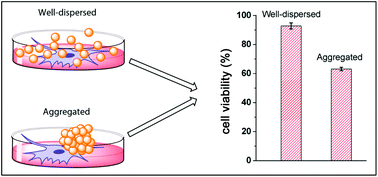
Dalton Trans., 2015,44, 17911-17915
https://doi.org/10.1039/C5DT02118A
Regulation of a cerium(IV)-driven O2 evolution reaction using composites of liposome and lipophilic ruthenium complexes
An O2 evolution catalyst system based on liposomes and lipophilic Ru(II) complexes was fabricated with regulating the surrounding environment of reaction centre.
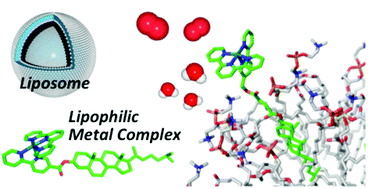
Dalton Trans., 2015,44, 15126-15129
https://doi.org/10.1039/C5DT00793C
Thermal conversion of a tailored metal–organic framework into lithium silicate with an unusual morphology for efficient CO2 capture
Thermal conversion of a Li- and Si-containing MOF produces ceramic Li4SiO4 with a coral-like morphology, which is an advanced CO2 absorbent with high uptake and fast absorption.
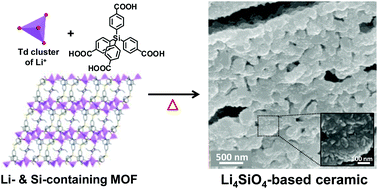
Dalton Trans., 2015,44, 15130-15134
https://doi.org/10.1039/C5DT00690B
Nano-sized Mn oxides as true catalysts for alcohol oxidation by a mononuclear manganese(II) complex
We propose that nano-sized Mn oxides are true catalysts for the oxidation of some alcohols to aldehydes in the presence of a mononuclear manganese(II) complex, and Oxone as an oxidant.
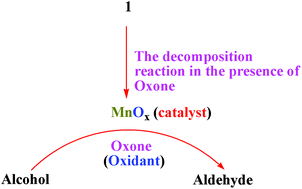
Dalton Trans., 2015,44, 15121-15125
https://doi.org/10.1039/C5DT01130B
A potential gradient along the layer-by-layer architecture for electron transfer rectification
Potential gradient along a phenylazomethine dendrimer structure can control favorable electron transfer direction.
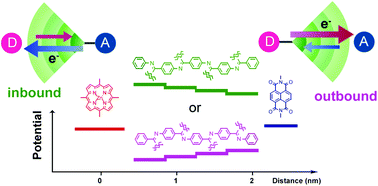
Dalton Trans., 2015,44, 15116-15120
https://doi.org/10.1039/C5DT00788G
C–H and H–H bond activation via ligand dearomatization/rearomatization of a PN3P-rhodium(I) complex
A neutral complex PN3P-Rh(I)Cl (2) was prepared from a reaction of the PN3P pincer ligand (1) with [Rh(COD)Cl]2 (COD = 1,5-cyclooctadiene).
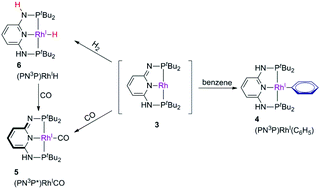
Dalton Trans., 2015,44, 15111-15115
https://doi.org/10.1039/C5DT00787A
Synthesis of magnesium ZIF-8 from Mg(BH4)2
Porous Mg(2-methyl imidazolate)2 (Mg-ZIF-8) was synthesised from Mg(BH4)2, and it possesses an uncommon tetrahedral Mg2+–N coordination geometry.
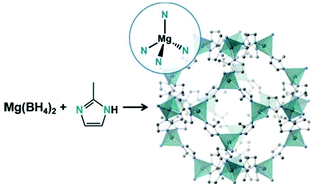
Dalton Trans., 2015,44, 15107-15110
https://doi.org/10.1039/C5DT01183C
Two phosphaalkene radical cations with inverse spin density distributions
Two phosphaalkene radical cations have been made by using a weakly coordinating anion, and they exhibit inverse spin density distributions.

Dalton Trans., 2015,44, 15099-15102
https://doi.org/10.1039/C5DT00656B
Heteroleptic bis(dipyrrinato)copper(II) and nickel(II) complexes
Heteroleptic bis(dipyrrinato)copper(II) and nickel(II) complexes are synthesized for the first time, and their structural, photochemical, and electrochemical properties are disclosed.
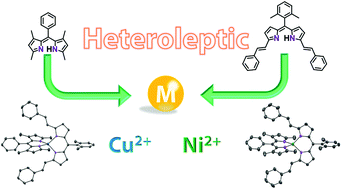
Dalton Trans., 2015,44, 15103-15106
https://doi.org/10.1039/C5DT00724K
Triphenylene-based tris-N-heterocyclic stannylenes
Two planar tridentate N-heterocyclic stannylenes synthesized from the corresponding 2,3,6,7,10,11-hexaamino-triphenylene and Sn[N(TMS)2]2 are reported.
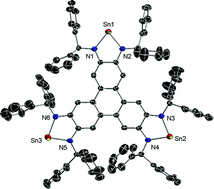
Dalton Trans., 2015,44, 15095-15098
https://doi.org/10.1039/C5DT00694E
Direct synthesis of size-tunable PbS nanocubes and octahedra and the pH effect on crystal shape control
Small PbS nanocrystals were synthesized by a one-pot procedure, but large octahedra were produced by changing the reagent introduction sequence.
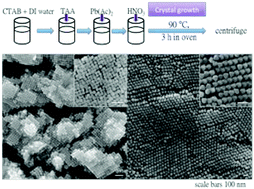
Dalton Trans., 2015,44, 15088-15094
https://doi.org/10.1039/C4DT03345K
A 2,2′-bipyridine coordination complex of [ICl2]+
A straightforward synthesis of a new type of iodine(III) complex is presented – an N′N chelated [ICl2]+ cation.
![Graphical abstract: A 2,2′-bipyridine coordination complex of [ICl2]+](/en/Image/Get?imageInfo.ImageType=GA&imageInfo.ImageIdentifier.ManuscriptID=C4DT03549F&imageInfo.ImageIdentifier.Year=2015)
Dalton Trans., 2015,44, 15083-15087
https://doi.org/10.1039/C4DT03549F
Abrupt two-step and symmetry breaking spin crossover in an iron(III) complex: an exceptionally wide [LS–HS] plateau
A rare iron(III) symmetry breaking spin crossover compound with an extremely wide [LS–HS] plateau is reported.
![Graphical abstract: Abrupt two-step and symmetry breaking spin crossover in an iron(iii) complex: an exceptionally wide [LS–HS] plateau](/en/Image/Get?imageInfo.ImageType=GA&imageInfo.ImageIdentifier.ManuscriptID=C4DT03184A&imageInfo.ImageIdentifier.Year=2015)
Dalton Trans., 2015,44, 15079-15082
https://doi.org/10.1039/C4DT03184A
Encapsulation of [(SO4)4(H2O)12]8− clusters in a metal organic framework of pyridyl functionalized cyanuric acid based tris-urea
Encapsulation of four sulfates in hydrated form is demonstrated in the coordination driven self-assembly of a tripodal urea receptor.
![Graphical abstract: Encapsulation of [(SO4)4(H2O)12]8− clusters in a metal organic framework of pyridyl functionalized cyanuric acid based tris-urea](/en/Image/Get?imageInfo.ImageType=GA&imageInfo.ImageIdentifier.ManuscriptID=C4DT02877E&imageInfo.ImageIdentifier.Year=2015)
Dalton Trans., 2015,44, 15075-15078
https://doi.org/10.1039/C4DT02877E
Cobalt(II) amido complexes derived from a monodentate arylamido ligand featuring a highly electron-withdrawing C6F5 substituent
A series of cobalt(II) complexes derived from the C6F5-substituted amido ligand [N(C6F5)(C6H3Pri2-2,6)]− (L) have been prepared and structurally characterized.

Dalton Trans., 2015,44, 17950-17959
https://doi.org/10.1039/C5DT00796H
Light-induced nitric oxide release from physiologically stable porous coordination polymers
A physiologically stable PCP based on titanium ions produces nitric oxide from bis-N-nitroso functionality on ligands under light irradiation.
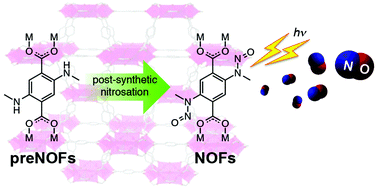
Dalton Trans., 2015,44, 15324-15333
https://doi.org/10.1039/C5DT01418B
Porous frameworks constructed by non-covalent linking of substitution-inert metal complexes
Flexible porous frameworks based on substitution-inert paddle-wheel Rh(II) dimers with active sites were successfully synthesized by using multipoint arene-perfluoroarene interactions and the porous properties of the frameworks were investigated.
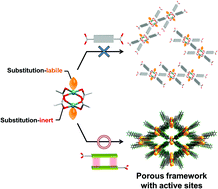
Dalton Trans., 2015,44, 15334-15342
https://doi.org/10.1039/C5DT01620G
Dual mode signaling responses of a rhodamine based probe and its immobilization onto a silica gel surface for specific mercury ion detection
The amino-ethyl-rhodamine-B based probe 2 appended with a 3-aminomethyl-(2-amino-1-pyridyl) group retained its Hg(II)-specific chromogenic and fluorogenic signaling responses in an aqueous medium even upon immobilization onto a silica gel surface for selective detection and extraction of Hg(II) ions.
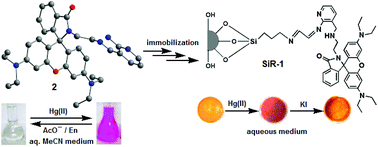
Dalton Trans., 2015,44, 15304-15315
https://doi.org/10.1039/C5DT01334H
Acetate anion-triggered peroxygenation of non-native substrates by wild-type cytochrome P450s
Wild-type cytochrome P450SPα and cytochrome P450BSβ can catalyze the oxidation of non-native substrates by performing the reaction at a high concentration of the acetate anion.
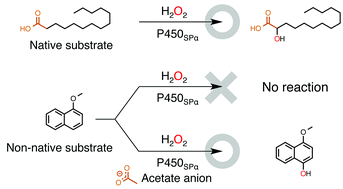
Dalton Trans., 2015,44, 15316-15323
https://doi.org/10.1039/C5DT00797F
Insertion, elimination and isomerisation of olefins at alkylaluminium hydride: an experimental and theoretical study
Individual steps of the aluminium-mediated contrathermodynamic isomerisation of internal olefins to α-olefins are studied.
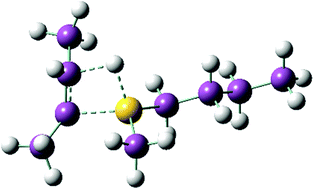
Dalton Trans., 2015,44, 15286-15296
https://doi.org/10.1039/C5DT00955C
Facile redox state manipulation in Cu(I) frameworks by utilisation of the redox-active tris(4-(pyridin-4-yl)phenyl)amine ligand
Two Cu(I) frameworks were synthesised with the NPy3 ligand and Cu(II) salts to yield electroactive Cu(I) frameworks whose spectral properties varied as a function of the redox state.
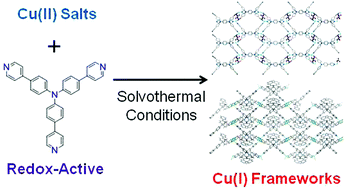
Dalton Trans., 2015,44, 15297-15303
https://doi.org/10.1039/C5DT01233C
An engineered polypeptide around nano-sized manganese–calcium oxide: copying plants for water oxidation
Herein, we introduce a novel engineered polypeptide containing tyrosine around a nano-sized manganese–calcium oxide, which was shown to be a highly active catalyst toward water oxidation at low overpotential.
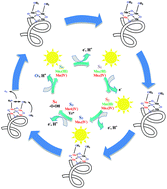
Dalton Trans., 2015,44, 15271-15278
https://doi.org/10.1039/C5DT01443C
Liquid-phase step-by-step growth of an iron cyanide coordination framework on LiCoO2 particle surfaces
The facile surface modification of LiCoO2 (LCO) – a positive electrode material for a lithium ion battery – with a framework compound, Prussian blue, in a step-by-step manner under operationally simple ambient conditions is described.
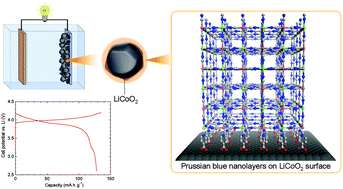
Dalton Trans., 2015,44, 15279-15285
https://doi.org/10.1039/C5DT00968E
Construction of hybrid films of silver nanoparticles and polypyridine ruthenium complexes on substrates
Two types of hybrid films of AgNPs and ruthenium complexes are constructed via chemical bond formation and electroreductive polymerization.
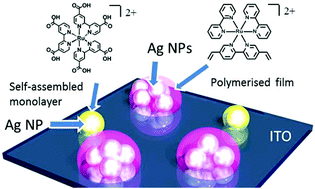
Dalton Trans., 2015,44, 15244-15249
https://doi.org/10.1039/C5DT00563A
Ethylene/propylene copolymerization catalyzed by vanadium complexes containing N-heterocyclic carbenes
An ethylene/propylene copolymer with random monomer distribution could be prepared with air-stable vanadium complexes containing the NHC ligand.
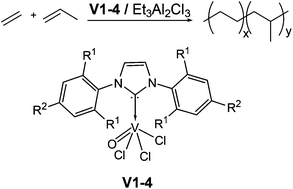
Dalton Trans., 2015,44, 15264-15270
https://doi.org/10.1039/C5DT00675A
Anion complexation with cyanobenzoyl substituted first and second generation tripodal amide receptors: crystal structure and solution studies
Solid and solution state anion binding via a side cleft and pseudocapsular fashion by two cyanophenyl substituted first (L1) and second (L2) generation tripodal amides has been demonstrated along with a selective anion induced conformational change of L2 from open C2v to folded C3v symmetry.
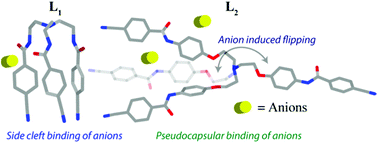
Dalton Trans., 2015,44, 15220-15231
https://doi.org/10.1039/C5DT00369E
Oxidation of methane by an N-bridged high-valent diiron–oxo species: electronic structure implications on the reactivity
Methane activation by dinuclear high-valent iron–oxo species: do we need two metals to activate such inert bonds? Our theoretical study using DFT methods where electronic structure details and mechanistic aspects are established answers this intriguing question.
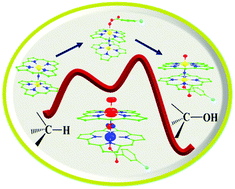
Dalton Trans., 2015,44, 15232-15243
https://doi.org/10.1039/C5DT01060H
Introduction of luminescent rhenium(I), ruthenium(II), iridium(III) and rhodium(III) systems into rhodamine-tethered ligands for the construction of bichromophoric chemosensors
Several classes of rhenium(I), ruthenium(II), iridium(III) and rhodium(III) complexes tethered with a rhodamine moiety have been synthesized and characterized, and their photophysical and ion-binding properties were investigated.
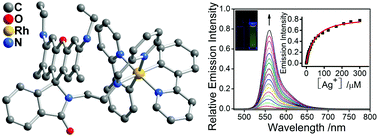
Dalton Trans., 2015,44, 15250-15263
https://doi.org/10.1039/C5DT00661A
Synthesis, characterization, photophysics and electrochemical study of luminescent iridium(III) complexes with isocyanoborate ligands
Highly phosphorescent cyclometalated iridium(III) complexes with isocyanoborate ligands.
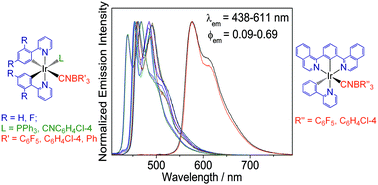
Dalton Trans., 2015,44, 15135-15144
https://doi.org/10.1039/C5DT00904A
Near-infrared (NIR) emitting Nd/Yb(III) complexes sensitized by MLCT states of Ru(II)/Ir(III) metalloligands in the visible light region
Visible light sensitized NIR emission of Nd3+ and Yb3+ by Ru(II)/Ir(III) metalloligands is reported.
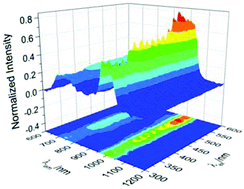
Dalton Trans., 2015,44, 15212-15219
https://doi.org/10.1039/C5DT00545K
Nanoscale metallogel via self-assembly of self-assembled trinuclear coordination rings: multi-stimuli-responsive soft materials
A multi-stimuli-responsive metallogel is obtained by the self-assembly of an already self-assembled trinuclear palladium(II) based coordination ring of the rare M3L6 composition.
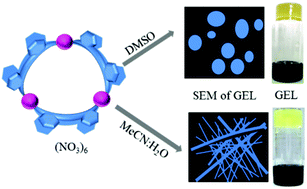
Dalton Trans., 2015,44, 15181-15188
https://doi.org/10.1039/C4DT03715D
Amino-ether macrocycle that forms CuII templated threaded heteroleptic complexes: a detailed selectivity, structural and theoretical investigations
Self-sorting behavior of a newly synthesized macrocycle with divalent metal ions and aromatic ligands via pseudorotaxane formation has been described.
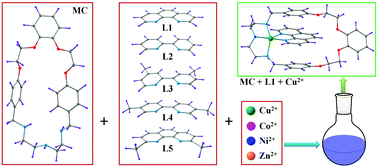
Dalton Trans., 2015,44, 15198-15211
https://doi.org/10.1039/C5DT00596E
Syntheses, structures, and magnetic properties of three new cyano-bridged complexes based on the [Mn(CN)6]3− building block
By tuning the reaction conditions and using macrocyclic ligands, three [Mn(CN)6]3−-based magnetic complexes were prepared and characterized.
![Graphical abstract: Syntheses, structures, and magnetic properties of three new cyano-bridged complexes based on the [Mn(CN)6]3− building block](/en/Image/Get?imageInfo.ImageType=GA&imageInfo.ImageIdentifier.ManuscriptID=C5DT00038F&imageInfo.ImageIdentifier.Year=2015)
Dalton Trans., 2015,44, 15189-15197
https://doi.org/10.1039/C5DT00038F
Aqueous phase selective detection of 2,4,6-trinitrophenol using a fluorescent metal–organic framework with a pendant recognition site
A metal–organic framework with a pendant Lewis basic recognition site was employed to achieve selective detection of the nitro explosive TNP in the aqueous phase.
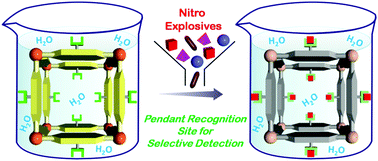
Dalton Trans., 2015,44, 15175-15180
https://doi.org/10.1039/C5DT00397K
Synthesis, structural studies and ligand influence on the stability of aryl-NHC stabilised trimethylaluminium complexes
Treatment of a series of aromatic NHCs with trimethylaluminium produced their corresponding NHC·AlMe3 adducts displaying different stabilities. Their stabilities are rationalized using topographic steric maps and NHC % V Bur.
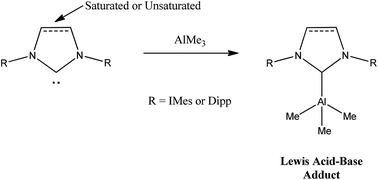
Dalton Trans., 2015,44, 15166-15174
https://doi.org/10.1039/C5DT00079C
1,2,4-Triazole-derived carbene complexes of gold: characterization, solid-state aggregation and ligand disproportionation
Reversible ligand disproportionation of gold(I) mono-carbene complexes also works for weaker triazole-derived carbene ligand.
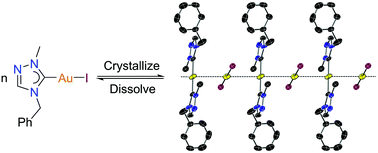
Dalton Trans., 2015,44, 15157-15165
https://doi.org/10.1039/C4DT03201B
Ruthenium(II) polypyridyl complexes as dual inhibitors of telomerase and topoisomerase
Three ruthenium(II) polypyridyl complexes, [Ru(bpy)2(icip)]2+ (1), [Ru(bpy)2(pdppz)]2+ (2), and [Ru(bpy)2(tactp)]2+ (3), were selected to inhibit telomerase by inducing and stabilising the G-quadruplex structure, and behave as topoisomerase I/II poisons at the same time.
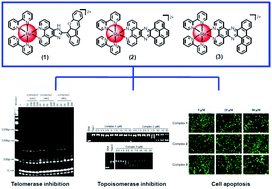
Dalton Trans., 2015,44, 15145-15156
https://doi.org/10.1039/C4DT03585B
About this collection
Guest Edited by Professor Hiroshi Nishihara (The University of Tokyo), this themed issue focuses on all areas of inorganic and organometallic chemistry, inorganic materials science, bioinorganic chemistry and catalysis, and aims to reflect the strength and vitality of new inorganic chemistry from the Asia-Pacific region.